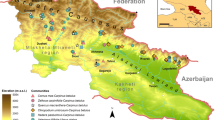Abstract
A TWINSPAN classification of a representative set of 3026 relevés of spruce and fir forests from the Eastern Alps (Austria) is presented. Ecological features of relevé clusters and species groups are described by means of Ellenberg indicator values, site factors and stand characteristics. The most important floristic discontinuity in the data set separates acidophilous communities on mostly silicate substrates from basiphilous communities on mostly carbonate substrates. Further divisions reflect a combined gradient of temperature, nutrient regime and shading. This is supported by the correlation of average Ellenberg values of sample plots with DCA axes. A qualitative comparison between TWINSPAN clusters and a syntaxonomic system widely used in the Austrian Alps is drawn. The two ordersPiceetalia excelsae andAthyrio-Piceetalia largely coincide with the clusters of the first level of divisions. Alliances are partly reproduced by TWINSPAN. Clusters on the fifth and fourth level of division mostly correspond to associations. However, a considerable portion of the lower level clusters is of a transitional type. Out of thirteen fir and spruce associations described for the Austrian Alps, five associations are not reproduced by TWINSPAN, i.e.Bazzanio-Piceetum, Veronico-Piceetum, Adenostylo alliariae-Abietetum, Asplenio-Piceetum andCarici-Piceetum. Three associations are split on the second level of division, i.e.Larici-Piceetum, Luzulo nemorosae-Piceetum andCalamagrostio variae-Piceetum.
Similar content being viewed by others
References
Adler W., Oswald K. &Fischer R. (1994):Exkursionsflora von Österreich. Ulmer, Stuttgart.
Aichinger E. (1933):Vegetationskunde der Karawanken. Gustav Fischer Verlag, Jena.
Braun-Blanquet J. (1964):Pflanzensoziologie. Grundzüge der Vegetationskunde. Ed. 3. Springer Verlag, Wien, New York.
Braun-Blanquet J., Sissingh G. &Vlieger J. (1939):Prodromus der Pflanzengesellschaften. Klasse der Vaccinio-Piceetea (Nadelholz- und Vaccinienheiden-Verbände der eurosibirisch-nordamerikanischen Region). Mari-Lavit, Montpellier.
Diekmann M. &Lawesson J.E. (1999): Shifts in ecological behaviour of herbaceous forest species along a transect from northern Central to North Europe.Folia Geobot. 34: 127–141.
Dierschke H. (1994):Pflanzensoziologie: Grundlagen und Methoden. Verlag Eugen Ulmer, Stuttgart.
Ellenberg H. (1996):Vegetation Mitteleuropas mit den Alpen in ökologischer Sicht. Ed. 5. Verlag Eugen Ulmer, Stuttgart.
Ellenberg H. &Klötzli F. (1972): Waldgesellschaften und Waldstandorte der Schweiz.Mitt. Schweiz. Anst. Forstl. Versuchswesen 48: 589–930.
Ellenberg H., Weber H.E., Düll R., Wirth W., Werner W. &Paulißen D. (1992): Zeigerwerte von Pflanzen in Mitteleuropa. Ed. 2.Scripta Geobot. 18: 1–258.
Etter H. (1943): Über die Waldvegetation am Südostrand des schweizerischen Mittellandes.Mitt. Schweiz. Anst. Forstl. Versuchswesen 25: 141–210.
Ewald J. (1997): Die Bergmischwälder der Bayerischen Alpen — Soziologie, Standortbindung und Verbreitung.Diss. Bot. 290: 1–234.
Ewald J. (1999): Soziologie und Standortbindung subalpiner Fichtenwälder in den Bayerischen Alpen.Tuexenia 19: 107–125.
Ewald J. (2000): The influence of coniferous canopies on understorey vegetation and soils in mountain forests of the northern Calcareous Alps.Appl. Veg. Sci. 3: 123–134.
Exner A. (2001): Die Syntaxonomie mitteleuropäischer Tannen- und Fichtenwälder.Ber. Reinhold-Tüxen-Ges. 13: 241–245.
Frey W., Frahm J.-P., Fischer E. &Lobin W. (1995):Die Moos- und Farnpflanzen Europas. Kleine Kryptogamenflora, Band IV. Gustav Fischer Verlag, Stuttgart, Jena, New York.
Glavač V. (1996):Vegetationsökologie. Grundfragen, Aufgaben, Methoden. Gustav Fischer Verlag, Jena.
Grabherr G. &Mucina L. (1993): Einleitung zum Werk “Die Pflanzengesellschaften Österreichs”. In:Mucina L., Grabherr G. &Ellmauer T. (eds.),Die Pflanzengesellschaften Österreichs, Teil I, Anthropogene Vegetation, Gustav Fischer Verlag, Jena, Stuttgart, New York, pp. 12–18.
Hennekens S.M. (1996):MEGATAB — a visual editor for phytosociological tables, version 1.0. Giesen & Geusts, Ulft.
Hennekens S.M. &Schaminée J.H.J. (2001): TURBOVEG, a comprehensive data base management system for vegetation data.J. Veg. Sci. 12: 589–591.
Hill M.O. (1973): Reciprocal averaging: an eigenvector method of ordination.J. Ecol. 61: 237–249.
Hill M.O. (1979):TWINSPAN. A FORTRAN program for arranging multivariate data in an ordered two-way table by classification of the individuals and attributes. Cornell University, Ithaca.
Hill M.O. &Gauch H.G. (1980): Detrended correspondence analysis: an improved ordination technique.Vegetatio 42: 47–58.
Jelem H. &Kilian W. (1966): Standortserkundung mit Waldbaugrundlagen Murauer Nockberge, Revier Paal.Forstl. Bundes-Versuchsanst. 20: 1–93.
Jelem H. &Kilian W. (1975): Wälder und Standorte am steirischen Alpenostrand. Wuchsraum 18.Mitt. Forstl. Bundes-Versuchsanst. 111: 1–167.
Jelem H., Kilian W. &Neumann A. (1964): Standortserkundung Volderberg-Pfons (Tuxer Alpen) Tirol.Forstl. Bundes-Versuchsanst. 14: 1–93.
Jirásek J. (1996): Společenstva přirozených smrčin České republiky (Natural spruce forest communities in the Czech Republic).Preslia 67 (1995): 225–259.
Kent M. &Ballard J. (1988): Trends and problems in the application of classification and ordination methods in plant ecology.Vegetatio 78: 109–124.
Kilian W., Müller F. &Starlinger F. (1994): Die forstlichen Wuchsgebiete Österreichs. Eine Naturraumgliederung nach waldökologischen Gesichtspunkten.FBVA-Berichte 82: 1–60.
Kuoch R. (1954): Wälder der Schweizer Alpen im Verbreitungsgebiet der Weißtanne.Mitt. Schweiz. Anst. Forstl. Versuchswesen 30: 133–260.
Mayer H. (1963):Tannenreiche Wälder am Nordabfall der mittleren Ostalpen. BLV Verlagsgesellschaft, München, Basel, Wien.
Mayer H. (1974):Wälder des Ostalpenraums. Gustav Fischer Verlag, Stuttgart.
Oberdorfer E. (1957):Süddeutsche Pflanzengesellschaften. Gustav Fischer Verlag, Jena.
Oberdorfer E. (ed.) (1992):Süddeutsche Pflanzengesellschaften. Teil IV. Wälder und Gebüsche. Gustav Fischer Verlag, Jena, Stuttgart, New York.
Olano J.M., Loidi J., Ander G. &Escudero A. (1998): Relating variation in the understorey of beech forests to ecological factors.Folia Geobot. 33: 77–86.
ter Braak C.J.F. &Gremmen N.J.M. (1987): Ecological amplitudes of plant species and the internal consistency of Ellenberg’s indicator values for moisture.Vegetatio 69: 79–87.
ter Braak C.J.F. &Šmilauer P. (1998):CANOCO reference manual and user’s guide to Canoco for Windows. Software for canonical community ordination (version 4). Microcomputer Power, Ithaca.
Tichý L. (2002): JUICE, software for vegetation classification.J. Veg. Sci. 13: 451–453.
Walentowski H. (1998): Die Weißtannen-Waldgesellschaften Bayerns.Diss. Bot. 291: 1–473.
Wallnöfer S. (1993):Vaccinio-Piceetea. In:Mucina L., Grabherr G. &Wallnöfer S. (eds.),Die Pflanzengesellschaften Österreichs, Teil III, Wälder und Gebüsche, Gustav Fischer Verlag, Jena, Stuttgart, New York, pp. 283–337.
Weber H.E., Moravec J. &Theurillat J.-P. (2000): International Code of Phytosociological Nomenclature. 3rd edition.J. Veg. Sci. 11: 739–768.
Willner W. (2001): Assoziationsbegriff und Charakterarten im Zeitalter der numerischen Klassifikation.Ber. Reinhold-Tüxen-Ges. 13: 35–52.
Wohlgemuth T., Schütz M., Keller W. &Wildi O. (1999): Errechnete Ökogramme für Schweizer Wälder.Bot. Helv. 109: 169–191.
Zukrigl K. (1973): Montane und subalpine Waldgesellschaften am Alpenostrand.Mitt. Forstl. Bundes-Versuchsanst. 101: 1–387.
Author information
Authors and Affiliations
Corresponding author
Rights and permissions
About this article
Cite this article
Exner, A., Willner, W. & Grabherr, G. Picea abies andAbies alba forests of the austrian alps: Numerical classification and ordination. Folia Geobot 37, 383–402 (2002). https://doi.org/10.1007/BF02803254
Issue Date:
DOI: https://doi.org/10.1007/BF02803254




